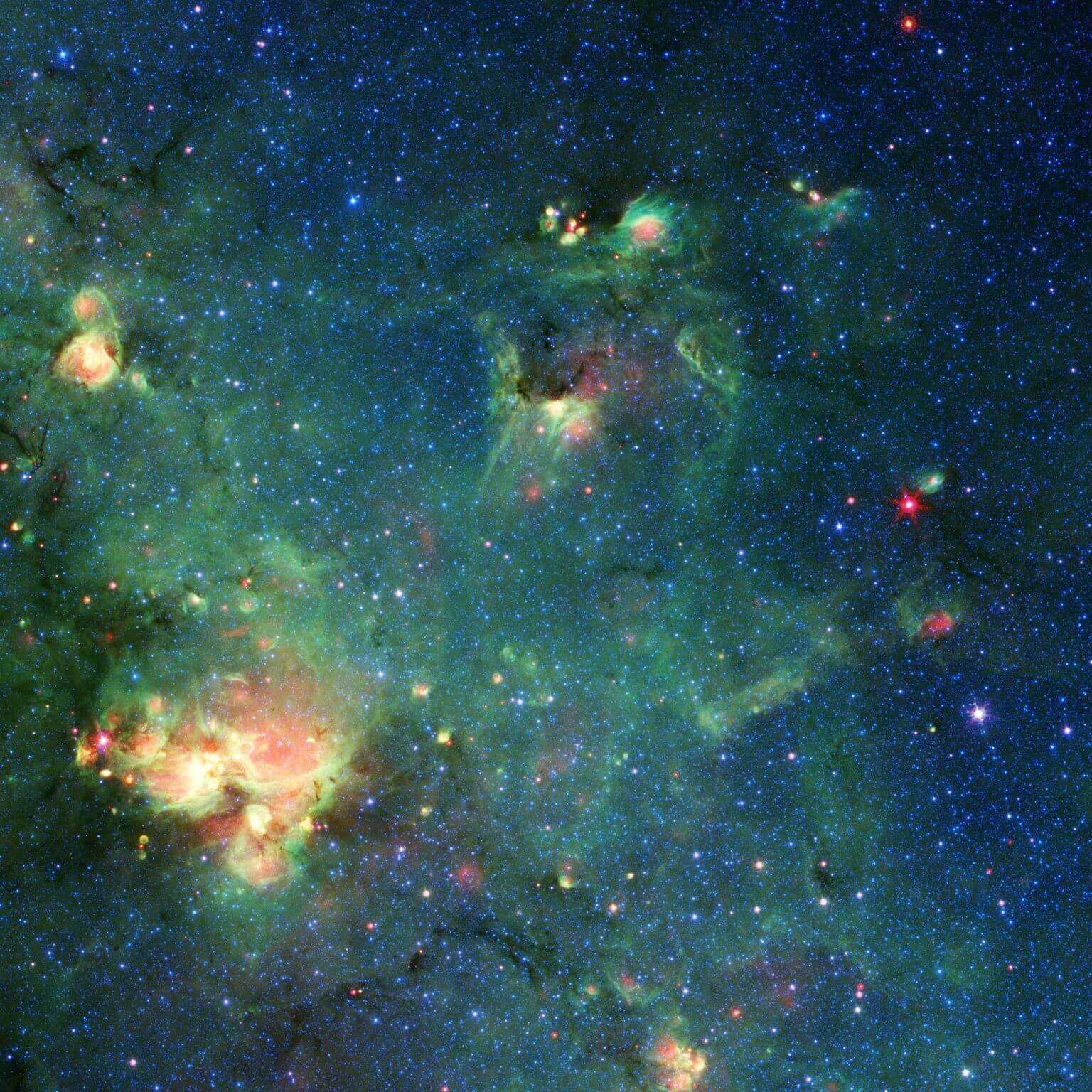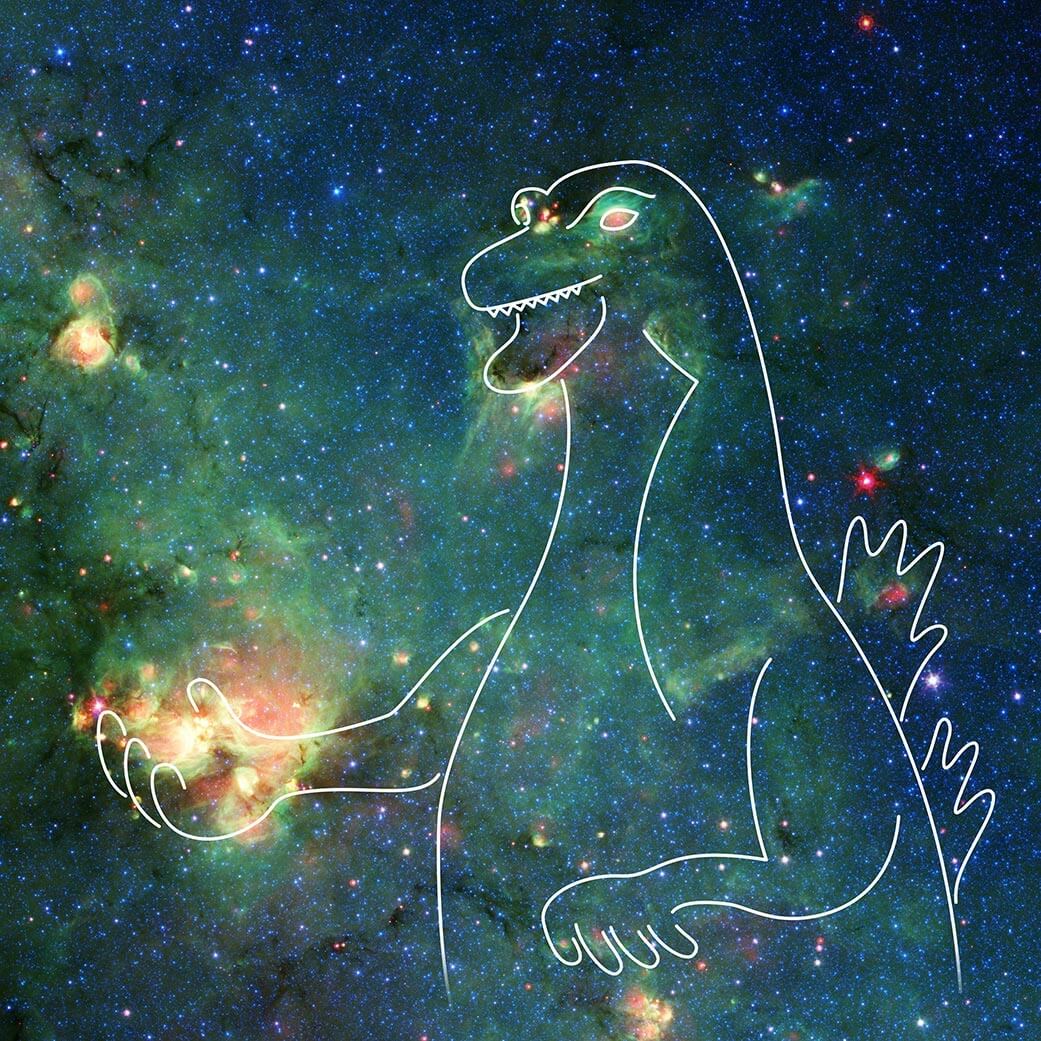Just like clouds on Earth, clouds of gas and dust in space can sometimes look like familiar objects, or even like characters from popular movies

Do you see a monster in this picture? Do the bright spots at the top of the image look like Godzilla's piercing eyes and elongated snout?
In reality, this colorful image shows a nebula - a cloud of gas and dust in space - taken by NASA's Spitzer Space Telescope. Over billions of years, countless stars formed from the material there. During their lifetime, the radiation they emit carves out the gas and dust, changing the shape of the cloud. Big changes also occur when massive stars die and explode, becoming supernovae. When viewed in visible light, the kind the human eye can see, this region is almost completely obscured by dust clouds. But infrared light (wavelengths longer than our eye can see) can penetrate through clouds and reveal hidden areas like this one.
Four colors (blue, cyan, green and red) are used to represent different wavelengths of infrared light, yellow and white are combinations of these wavelengths. Blue and cyan represent wavelengths emitted primarily by stars, dust and organic molecules called hydrocarbons appear green, and hot dust heated by stars or supernovae appears red.
Meet the person responsible for Spitzer's photos

This image was processed by Caltech astronomer Robert Hart, who is responsible for most of the public images created from Spitzer data since the observatory launched in 2003. Hart is also the one who spotted Godzilla in the picture.
"I wasn't looking for monsters," he said. "I happened to be looking at an area of the sky that I had looked at many times before, but had never focused on. Sometimes if you just cut an area differently, it highlights something you didn't see before. The eyes and the mouth roared at me "Godzilla".
Hart is not the only one who tends to see earthly objects in images of the cosmos. Preidolia is the scientific name for the human tendency to perceive a specific, usually meaningful, image in random or obscure visual patterns. Other scientists identified, among other things, a black widow spider, a snake, a bare human brain and the spaceship Enterprise in Spitzer's images.
The Spitzer spacecraft operated by NASA's Jet Propulsion Laboratory in Southern California was decommissioned in January 2020, but scientists continue to search its large database for new information about the universe. And Hart continues to look for fascinating images.
"This is one of the ways we want to get people to connect with the great work that Spitzer has done," he said. "I look for fascinating areas that can really tell a story. Sometimes it's a story about how stars and planets are created, and sometimes it's about a huge monster rampaging through Tokyo."
The Godzilla-like nebula is in the constellation Sagittarius, along the plane of the Milky Way. The stars in the upper right (where Godzilla's eyes and snout are) are at an unknown distance from Earth but within our galaxy. The bright area in the lower left (Godzilla's right hand) is called W33 and is 7,800 light years from Earth.
Not convinced this dramatic star-making zone looks like Godzilla? You can draw your own cosmic creature with the web application Spitzer Artistronomy. New nebulas, including this nebula, were added to the app this month. The application has a drawing tool and images of nine nebulae taken by Spitzer, and users can illustrate how they see cosmic beings.
More on the subject on the science website:

3 תגובות
captivity
What is wrong with this article??
What is meant by expressing an opinion? Don't we see such a star formation area?
"The scientist". You have chosen a name that is a little too big for you. I have read your articles from time to time and although you are very knowledgeable, but you present your opinion on various subjects as scientific knowledge. To mislead people whether maliciously or not, what else is unknown if you have foreign or strange interests of any kind
Change the name of the website to: "expressing an opinion" and stop pretending to be a qualified scientific source because you are not